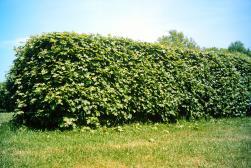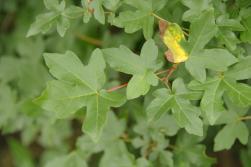Top MAPLES Under 10 Metres for Urban Home Landscapes (Zone 5)
- Martin Ford
- Mar 21, 2020
- 6 min read
Updated: Sep 15, 2020
Our new ‘Top Trees’ series highlights Martin’s favourite trees under 10 metres for use in urban home landscapes. It's March Maple Madness!

All noted trees are 10 metres or less in height at maturity, designated for Zone 5 (or under), and are native to, or naturalized within, Ontario.
Medium (10m high x10m wide)
Hedge Maple (Acer campestre)
Hedge Maple is an adaptable and trouble-free tree ideal for smaller urban spaces. Features interesting corky bark and a lovely texture via dark-green lobed leaves, plus a bright yellow fall colour! Small, rounded and low-branched, it typically grows in multiple stems. May be pruned into a wide canopy for sitting underneath - or sheared to form a tall hedge. Popular as a bonsai, shade or street tree.
Image credits: 1-3. Landscape Ontario
Zone, Growing Conditions & Requirements
Zones 5-8. Native to Europe and western Asia, frequently found on plains, hills and along rivers. It is also sometimes commonly called field maple (campestre means ‘from fields’). It is a good maple species for gardens in urban areas as it can handle problems like pollution, drought, and compacted soil.
While ultimately not a tall tree, hedge maple does eventually develop a fairly wide crown, which at low heights will limit it as a street tree in some situations.
Exposure/Culture: Grows in full sun to part shade, in all soil textures and pH adaptable. Generally tolerant of urban conditions: moderate salt tolerance, extremely drought tolerant, and easily transplanted.
It is pest resistant, though tar spot and verticillium wilt do occur. Maple tar spot infection is not currently as severe as seen on Norway maple (Acer platanoides). The plentiful seeds germinate easily; caution near natural areas as it is now listed as invasive in Ohio.
Highlights & Design Tips
Rounded with low branching and a short trunk; slender branches - often with corky fissures - gives this tree a medium to fine texture. Typically grows in cultivation up to 10 metres tall and wide. Dark-green leaves have rounded lobes and are smaller than the other, more commonly grown maple species in Ontario.
Use as an accent; for hedges and screening; windbreaks and shelterbelts; shade, lawn or street tree. Tolerates tight pruning. As its common name suggests, it may be pruned to form a tall hedge or in hedgerows.
Choose the 'Pulverulentum' cultivar if you want a plant with variegated leaves and 'Postelense' if you want yellow foliage. 'Compactum' is a dwarf cultivar. If you are interested in creating a bonsai, this is an excellent choice for a maple tree species. Try to find the 'Microphyllum' cultivar as it has smaller leaves that are well suited to one of these tiny trees.
Sources + more info:
1. The Spruce
Small (7m tall x 6m wide)
Acer griseum – Paper Bark Maple – 7m and 6m
All-season colour & interest make it a unique standout in the landscape:
· Forms a loose, open canopy & provides dappled shade
· Peeling, shiny reddish-brown bark is dramatic against a snowy backdrop
· Leaves are uncommonly pretty even in summer when its dark-green top colour contrasts with silvery-green underside
· Foliage turns a brilliant red in fall
This tree has a lovely trunk with thin peeling bark revealing a light brown, shiny underbark. It’s slow-growing and will form a loose, open canopy that provides dappled shade. Brilliant red fall leaf colour and resistant to most diseases. There are several varieties – ‘Fireburst’ has particularly strong fall colour and a more open branch structure.
Image credits: 1-2. Doreen Wynja.com; 3. NetPS Plant Finder
Zone, Growing Conditions & Requirements
Zones 4 to 8. Grows in full sun to part shade. Tolerates clay soil; low maintenance and medium water requirements.
Highlights & Design Tips
Unlike many maples, paperbark maple is an excellent small tree for small yards where it can work well as an ornamental specimen near a deck, patio or other conspicuous location to provide the best view of the tree's seasonal transformations. May also be planted as a lower-level tree below a towering canopy of taller trees. Popular amongst bonsai enthusiasts due to its slow growth.
Paperbarks produce greenish flowers in spring (usually April), but the blooms are not significant. The flowers then give way to the familiar maple seed samaras (winged seed pods), about 1 1/4 inches long. The seeds are unusually large for maples.
Sources + more info:
1. The Spruce
Medium (10m tall x 6m wide)
Acer rubrum – Red Maple ‘Brandywine’
This is a fast-growing tree that brings a classic, northern look even to new homes. Its oval habit and upright form is ideal for smaller home landscapes and used as an accent, shade, or vertical accent tree.
Rubrum = Red: Red flowers cover bare branches in spring. Red two-winged samaras (fruit). Brick-red branches. Red buds. Fall colour varies from red to purple in a spectacular, long-lasting display. Its furrowed gray bark and green foliage throughout the season act as contrast and lend interest to the landscape.
Image credits: 1-2. NetPS Plant Finder; 3. Daniel Tigner, Canadian Forest Tree Essences
Zone, Growing Conditions & Requirements
Zones 4-8. Brandywine Red Maple is a selection of a native North American species. Low maintenance and establishes easily and quickly. This tree does best in full sun to partial shade. It prefers to grow in average to moist conditions, and shouldn't be allowed to dry out. It is not particular as to soil type or pH and somewhat tolerant of urban pollution.
It has a low canopy with a typical clearance of 4' from the ground and should not be planted under power lines. Under ideal conditions, it can be expected to live for 70 years or more. Should only be pruned in summer after the leaves have fully developed, as it may 'bleed' sap if pruned in late winter or early spring. It has no significant negative characteristics.
Highlights & Design Tips
Brandywine Red Maple is a dense, deciduous tree with a shapely oval form. Its average texture blends into the landscape, but can be balanced by one or two finer or coarser trees or shrubs for an effective composition. Plant as a specimen tree for the lawn, street or park.
Fall colour is a brilliant scarlet that gradually turns reddish-purple. Fall color is more intense with more consistent quality red foliage color from year to year than what is typically found on species plants. 'Brandywine' is the result of a 1982 cross (Acer rubrum 'October Glory' x Acer rubrum 'Autumn flame') conducted as part of a U. S. National Arboretum research project, and introduced to market in 1995.
*NOTE: This tree has a shallow, flattened root system that may buckle nearby sidewalks or driveways if planted too close.
Sources + more info:
Small-Medium (8m tall x 7m wide)
Acer tataricum – Amur Maple ‘Hot Wings’
Suitable for small, urban landscapes due to its tolerance of challenging site conditions, freedom from pests, and fine fall colours. Adds all-season interest & beauty. In spring, it has yellow & white flowers and a red base leaf underneath each cluster of flowers. Flowers are followed by long, winged samaras that develop into a showy orange-red colour from summer to fall. It makes a fine ornamental specimen when grown with one or multiple trunks.
Image credits: 1. Plant Select.org; 2. Connon Nurseries; 3. Missouri Botanical Garden
Zone, Growing Conditions & Requirements
Hardy to zones 2-3 - one of the most winter hardy introduced maples. Moderate growth rate reaching 4-8 metres. Grow in full sun to part shade. Tolerates: all soil types and a wide range of pH, occasional wet to very dry soils. It is moderately sensitive to salt. Few pest or disease issues. Easy to transplant and prune to produce shape for desired use.
A tough tree with a dense crown. Leaves turn yellow and red in fall. Greenish-white flowers in erect, long-peduncled panicles bloom in spring. Flowers are followed by winged samaras (to 1” long) that turn a showy red in summer/fall as they mature.
Highlights & Design Tips
It makes a fine specimen when grown with one, or two to three, trunks. Several cultivars have been selected, including 'Flame'. It was selected for its bright red leaf and fruit red fall colour, however, it is often seed propagated leading to fall colour variability. In cold climates, Amur Maple has been used as a shrubby, lightly pruned, hedge windbreak.
Usage: Bonsai, planter, hedge, specimen, street tree; settings away from natural areas, specimen, patio or small residence tree for shade, planter boxes, mini-groves or groupings.
In cold climates, Amur maple has been used as a shrubby, lightly pruned, hedge windbreak.
This plant is often chosen for its showy samaras. Abundant, easily germinated seeds put Acer tataricum subsp. ginnala on the U.S invasive plant list for 7 states. Amur maple tolerates challenging growing conditions well but is best in urban settings where seedlings will not infiltrate natural areas.
Sources + more info:






















